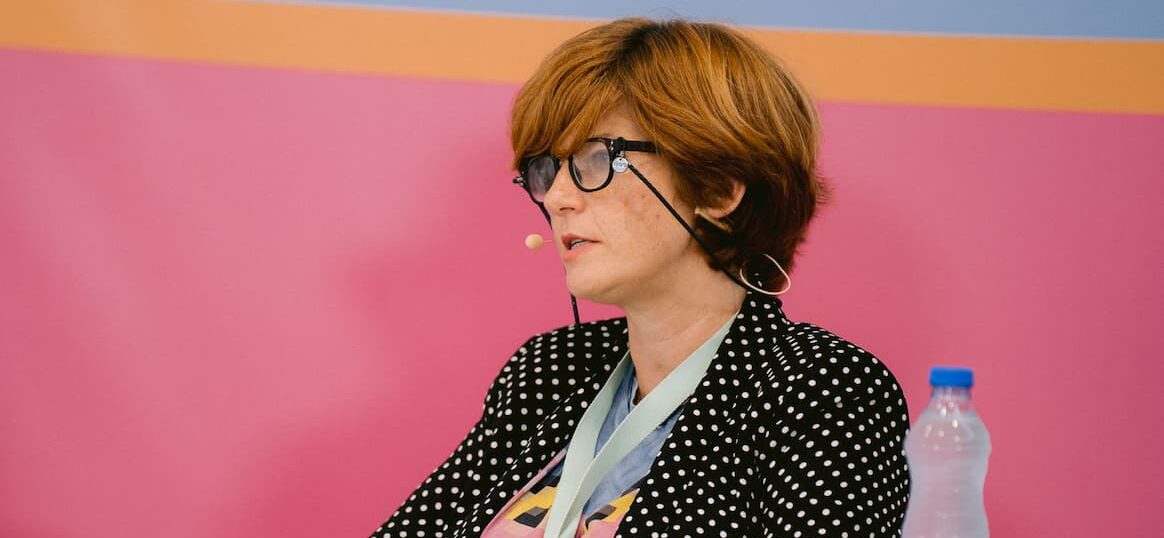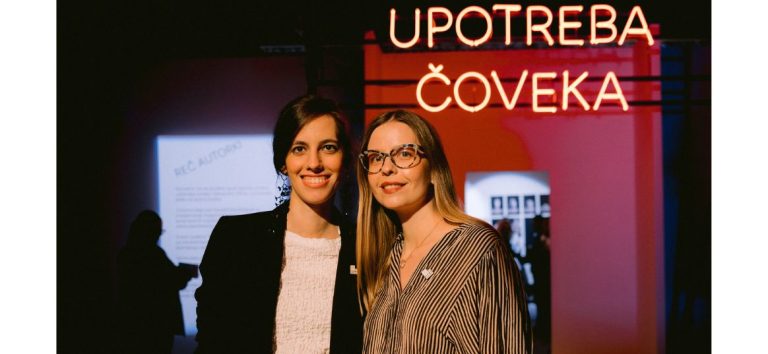The opening of the fifth Kaleidoscope of Culture in the District, a new centre of artistic creation in the European Capital of Culture, also marks the Biennale of Stage Design. As many as six exhibitions in the District are dedicated to stage design, which you will have the opportunity to see until 9 September. It is interesting that they promote the so-called invisible people of the theatre, the masters of the craft in the background, who do not receive applause from the audience after the performance, and without whom theatres would not exist.
We took the opportunity to talk with the artistic director of the Biennale, Mia David, who revealed to us how this festival was created, and what its greatest success is.
Mia David is an architect and set designer who has many years of experience in the field of contemporary visual art, performing arts, education and cultural management. She builds her pedagogical experience as an associate professor at the Faculty of Technical Sciences in Novi Sad, while she gained it at the Faculty of Dramatic Arts in Belgrade. She has exhibited her works throughout Europe, America and Russia, and is the winner of numerous prestigious awards and recognitions for her contribution to culture.
Could you tell us about the concept of this year’s Biennale of Stage Design, i.e., what the audience has the opportunity to see during the opening of the Kaleidoscope of Culture?
The Biennale of Stage Design is an event founded by JUSTAT – OISTAT Centre Yugoslavia and the Museum of Applied Art in Belgrade in 1997. The event included a large exhibition, awards and recognitions and a series of lectures, workshops and conferences. The Biennale existed until 2006 and gained a great national and regional reputation. We have been thinking about renewing the Biennale for some time. The fact that this year Novi Sad is the European Capital of Culture, and that the School of Stage Design, which is actually the most significant ‘product’ of the old Biennale, is located at the Faculty of Technical Sciences in Novi Sad, somehow determined that it should happen now.

Unlike the old one, which was national, this renewed Biennale deals with the area of the former Yugoslavia. In this context, BiSD is first and foremost a platform, a meeting place (both physical and digital) for both professionals and students who share the same cultural space. All programmes are regional and our goal is to establish a community and facilitate the exchange of knowledge, experiences, acquaintances and cooperation. Another important task of BiSD is to establish evaluation in all fields of stage design (both in the theatre and in non-theatre, artistic and curatorial practices). It is significant not only to be able to compare, but above all to give space to disciplines that are often neglected and invisible, or due to their interdisciplinary nature, cannot enter the usual classifications. This year, the Biennale of Stage Design is actually a festival that has more than 20 events in 9 programme units. There are exhibitions, workshops, lectures, panels, etc.
How would you explain the phenomenon of fluidity as the main thematic unit of this year’s Biennale?
The topic of the Biennale of Stage Design 2022 is fluid scenes and landscapes of loneliness. Fluidity is understood in the way that one of the most important sociologists and philosophers of the 20th century, Zygmunt Bauman, talks about. We see the phenomenon of fluid scenes as a search for authentic experiences, for presence in the real world and connection with it. We oppose this phenomenon to the feeling of loneliness of the modern individual, who still has the need to create a common, collective experience. Of course, this topic has to do with the recent experience of the pandemic, which increased loneliness even more, but at the same time, it also made people aware of the need for togetherness, belonging, creating a collective. We will deal with this topic mostly at the Symposium, (which is open to all) where some of the most important authors in the fields of stage design will talk about their practices.
The Biennale promotes the so-called invisible people of the theatre, those in the background, behind the scenes, who create magic. We are now putting them in the spotlight. This is exactly the backbone of the Biennale’s main exhibition, ‘Master’s Letter’, dedicated to the skills of people who work in the craft workshops of the theatre, play a major role in the theatre, and never receive applause for their work. How did the idea for this exhibition, which includes the works of craftsmen of as many as 16 theatre in Serbia and the region, come about?
Master’s Letter is the main exhibition of this year’s BiSD. It is dedicated to works of craft, i.e. knowledge, skills and experience in making (most often handmade) objects and parts of decor, costumes, props and dolls, in theatre workshops in the area of the former SFRY, in the period from 2006 to 2022. The curator and author of the project, Tatjana Dadić Dinulović, wished to focus on the people who work in the theatre, whose work we, as an audience, admire, but never up close. She and Darinka Mihajlović aka Selena Orb chose the works by masters created in 16 theatres from Belgrade, Budva, Ljubljana, Novi Sad, Podgorica, Sarajevo, Subotica and Zagreb. The ‘Makers of Magic’ exhibition, where the audience can see interviews with some of the masters, deals with the same topic.

What are your expectations from the project?
This year’s BiSD is already successful because we have a lot of guests coming to the programme, which is very extensive. Therefore, I expect people to meet, socialize and make some connections for the future. There will also be awards for stage design in the theatre… All in all, I expect that we will have a good time and lay the foundation for future Biennale.
Part of the Biennale of Stage Design is also the Children’s Biennale, a programme made up of numerous workshops intended for children aged 6 to 10. What kind of workshops will the youngest enjoy?
The Children’s Biennale is a programme led by Dragana Pilipović, who has been running the SCENlab kindergarten for years. She will develop a puppet theatre with the children by making set designs (mobile boxes for performing plays), i.e. a play area where children will move the puppets in different ways – from above with their hands, with puppets that are put on their hands (guignols) or with face masks. In addition to the children’s BiSD, we also have Youth BiSD, where teenagers will be able to get acquainted with various areas of stage design through numerous workshops.

What, in your opinion, is the greatest success of this great event, and what do you see as your personal success as the artistic director?
It is a success that we have implemented such a large project. The success is the huge response of people from the region. Over 100 registered authors for the monograph publication that we are preparing next year was also a huge success. Personally, this was a difficult process in which I asked myself many times why I was doing all this, but it is a great satisfaction when you see the response of people from the entire former Yugoslavia.
How challenging is such a complex project when you are at the very head of an event that has a national and regional reputation? What kind of cooperation do you have with other team members, since projects like this require teamwork?
It is very challenging. If it was not like that, I probably would not do it. It is challenged on many levels. This is a very ambitious project in terms of programme, and even more in terms of production and organization. When you add to that that everyone is doing volunteer work, then it gets even more complicated. Still, we consciously chose that model, because this is an event that is primarily intended for ourselves. The logic was – if it is not important to the profession and students, then it should not exist. It turned out that it should. However, no matter how much we volunteer, everything costs money. That is why the European Capital of Culture framework was the best solution for us. We decided that the main part of the budget goes to bringing guests, that this is the opportunity to meet ‘live’. The most important thing is to create a community. This is done by creating a space, both physical and virtual, in which people feel good.

The team that makes this Biennale comes from the Faculty of Technical Sciences, from the Department of Art and Design and it consists of several teachers and many students. Our job is to create events like this, but that does not mean the process was easy. We are different, we deal with different things, we have different work processes and different experience in practice. However, as colleagues we know each other well, we do different things together, so we are well organised in many things.
What does the Biennale of Stage Design represent for our cultural, and above all, theatre scene?
During its existence from 1997 to 2006, the Biennale achieved great importance for a number of disciplines that are rarely in focus. It pointed out the complexity of the stage design field, illuminated some people and phenomena and opened the way for many creators. Our task now is to extend the importance to the region and to recognize the characteristics of this time and adapt the focus and way of working to that without deviating from the values on which BiSD was founded.
Your interesting biography points to different fields of interest that intertwine with each other. You have exhibited in major cities around the world, you run the Navigator gallery, you teach at the Faculty of Technical Sciences in Novi Sad at the Department of Stage Architecture and Design. How do you manage to achieve all that, and what do you see as the greatest responsibility but also the biggest challenge of teaching work and youth education?
My biography is colourful, but there is one thing in common. I deal with space and text. All kinds of spaces, physical, mental, virtual… and different types of text reading: pretext, context, meta text… In addition to everything I did, and I really did all kinds of things, the job of a professor is certainly the most important. I believe that education and culture, but above all education, are the most important areas for a society. That is why I feel a great privilege and responsibility in working with students. My experience is that when we commit to them, they become phenomenal. The solution is to be honest with the students, to convey the passion. It does not matter if that passion is theirs too, it is important that they see that it is possible to live passionately even in adulthood. That growing up does not necessarily mean giving up.
Author: Marina Marić
Photo: Vladimir Veličković, Jovana Semiz








